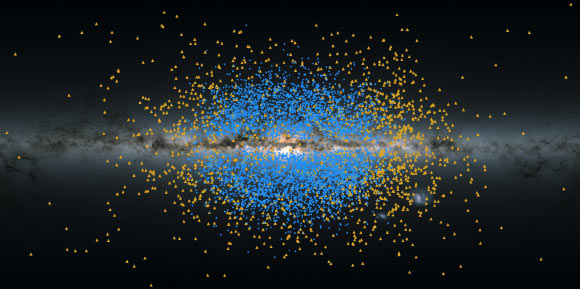The Heart of the Galaxy: Ancient Stars Shakti and Shiva

A team of leading scientists from the Max Planck Institute of Astronomy, led by Dr. Khyati Malhan and Dr. Hans-Walter Rix, have made an incredible discovery. They have identified two ancient star clusters, Shakti and Shiva, which played a crucial role in the formation of the galaxy that contains our own planet.
Using data from the powerful Gaia Sky Mapper satellite, provided by the European Space Agency (ESA), the researchers were able to analyze the structure and composition of these ancient stars. The Shakti and Shiva clusters, named after important gods in the Hindu religion, merged together approximately 12 to 13 billion years ago, helping the galaxy develop rapidly.

According to Sci-News, these colossal star clusters are estimated to be 13 billion years old. Remarkably, despite the significant changes the galaxy has undergone since its inception, these two star clusters still stand out at the center. They possess distinct chemical compositions that differentiate them from the rest.
Dr. Khyati explains, “When we mapped the orbits of the stars in this region, these two structures stood out from the rest, with their unique chemical makeup.” Dr. Rix further added that the ancient stars of Shakti and Shiva lack heavy metal elements, which are typically formed in older parts of the universe.
These star clusters, located at the heart of the galaxy, are often referred to as the “old and poor heart” of the Milky Way. In the widely accepted theories of cosmology, the early universe contained only a few light elements. The first generation of stars was primarily composed of these elements, making them extremely metal-poor. However, the cores of these stars served as the reactors that forged heavier elements.
Over the course of 13.8 billion years, the universe gradually became chemically enriched, resulting in the diversity of elements we observe today. Therefore, anything that remains chemically poor is believed to be part of the primordial universe. The discovery of Shakti and Shiva contributes to our understanding of the formation of the galaxy that houses our Earth.
Apart from Shakti and Shiva, other ancient remnants that formed the primitive heart of the Milky Way include Gaia-Sausage-Enceladus, LMS1/Wukong, Arjuna/Sequoia/I’itoi, and Pontus. These star streams, gas filaments, and peculiar structures add depth to the family tree and historical records of our galaxy – a mission that Gaia has been diligently working on for the past decade.
The groundbreaking research conducted by the Max Planck team has been recently published in the Astrophysical Journal. For more fascinating insights into the universe and the latest news in finance and economics, visit Business Today.
